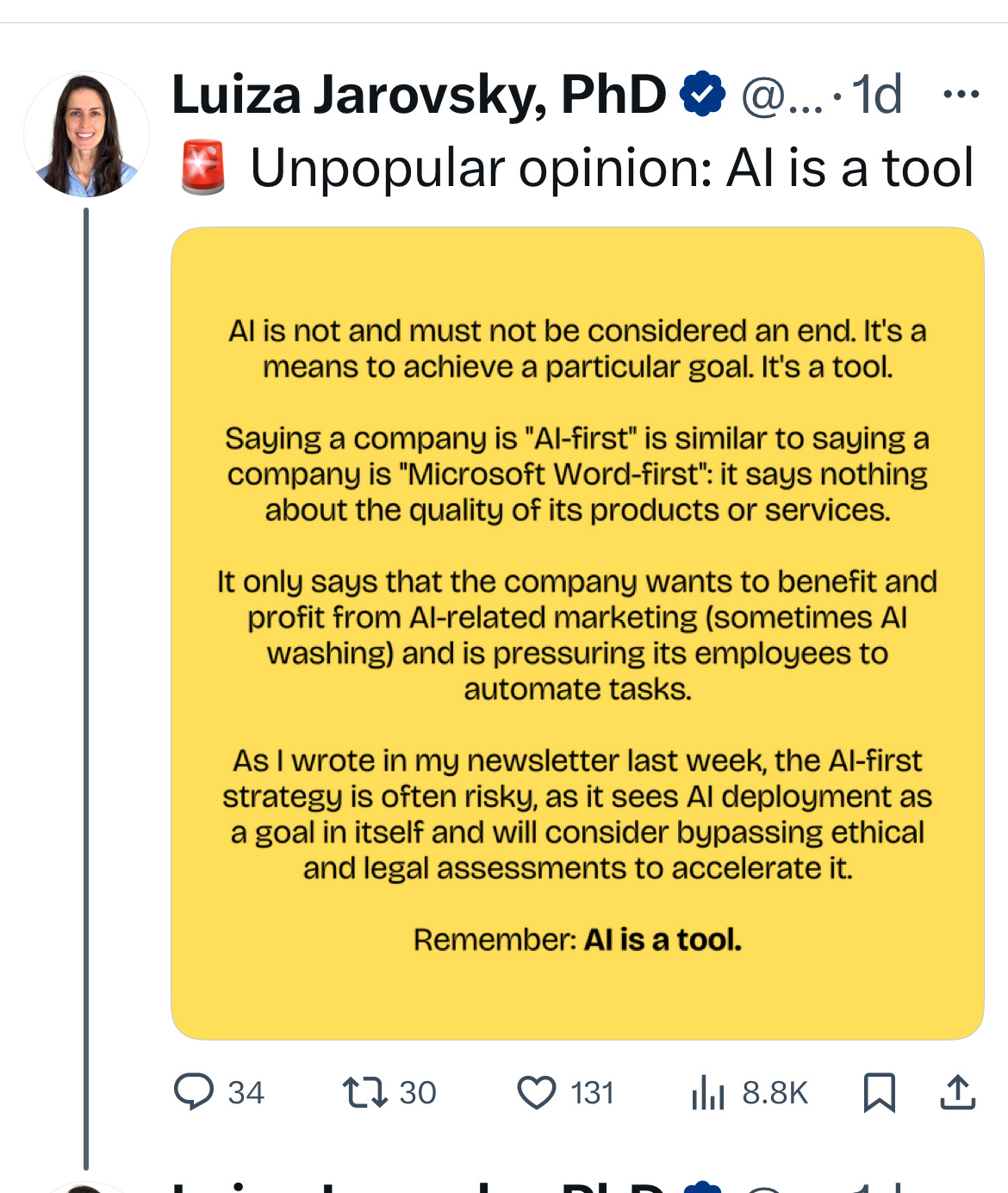The time has come the Walrus said to talk of AI hype
PLUS Lots of hype, a Cold War story, some menu mistakes and a closing thought
You know that situation is getting dire when I invoke the Walrus. In 2 weeks the same Walrus will cast a discerning eye on how my 2025 Tech predictions are doing. Here is the original article from 2024 for those who missed it.
First Course of READERS POTLUCK: The manufacturing of AI evidence
Another great reader submission - please keep them coming - about how a small unimportant university - MIT - has had to back away hard from an economics paper that purported to show the tremendous advantage garnered in materials science research from using an AI tool. The startling conclusions made by an up and coming graduate student were given the two thumbs up 👍 👍 by MIT’s leading economists and were reported deeply and globally. The new press release states that MIT now has “ no confidence ….in the veracity of the research”. Evidently the data was…… just made up.
Science, supposedly our source of empirical truth, is having a couple of decades of problems. These are mostly contained to the social sciences, where very few research studies can be replicated. Replication is one of the key planks of the scientific method. On top of this, is the blatant data distortion and manipulation that is surfacing on many scientific research projects, including the infamous “honesty expert likely uses dishonest data” incident.
All of this makes our upcoming main course about hype all the more difficult.
MAIN COURSE: Anecdote vs Evidence: Can we get ever to the bottom of the AI hype?
I have a longer article coming out later this week dealing with the whipsawing we are all currently experiencing regarding anything about AI. AI-washing is everywhere and in everything. Evidently Kool-Aid now has AI crystals to make the grape taste grape-ier.
A casual stroll through the feed of most social platforms will look like this:
AI great
AI terrible
AI gave me an exponential leap in productivity
AI seems to be leeching our very ability to think
RINSE AND REPEAT
Much of this is a an ordinary battle for the triumph of AI in business organizations, so my 🚩alert is on the highest setting for marketing spin, also known in the vernacular, as BS. Anything to sell more of this AI stuff. Think I’m hyping the hyping. Here is a quote from an academic AI researcher Luiza Javorsky:
“My first comment is that in recent months, the term “AI” seems to have become dusty, and major AI-related initiatives are now called “superintelligence.”
Check on some AI leaders - that is, the key people at AI vendors selling you their wares - and you will see that she is correct. The only way they could get more hype is to state that it is like God is built into every product.
Except of course most people are using free or cheap versions of the various AI tools and the cumulative vendor financial losses are the only real colossal thing about this. Well, except for Nvidia who provides the unbelievable horsepower to hyper-charge this story up. (And it is unbelievable, given the speed that many of less experienced AI users get deceived by: “It is just so fast” in a breathless whisper I have heard more than a few times now).
I’m not sure how my much-loved ordinaries are faring in this amplified goldfish bowl. Consider one of my favourite whipping boys, Marc Benioff (seen below making one of his landmark announcements, I think about how he invented Hallowe’en). Salesforce, his company, recently released a research paper in how well AI was doing in customer service, an initial primary target of agentic systems.
Actually not very well. The research is filled with AI jargon that gets in the way of comprehension. Let me explain in terms real businesses need to understand. If a customer asks a simple question the AI has a 58% chance of giving a correct answer. If another question comes from the same customer - likely as these are often conversations - it drops down to a 35% likelihood of being correct. And so on, with a profound range of other errors that were found. That is hardly great customer service. Maybe some companies don’t care anymore?
Meanwhile in advance of Salesforce Connections 2025 conference in Chicago, Marc was adding to the wind in that city with huge proclamations about the power of AgentForce, their digital agent product. What he is really crowing about is the actual and prospective sales of his new widgets. Big buckaroos. The dull but rigorous studies his people in the bowels of Salesforce report on is how well the widgets do in action. Not well as we have seen.
AI isn’t a lifestyle movement; it is a useful, important and very flawed set of technologies.
MENU MISTAKES
Was that an episode on Star Trek: Then Next Generation or Deep Space 9?
One more answer to the question: What else can AI do for us?
EXTRA HELPINGS: Want to know how cold the Cold War was?
This is not a climate change question but a military and political one. It also has to do with the lessons people older than 60 often learned, living under a constant threat of nuclear annihilation. (Much worse than The Last of Us).
Here are a two examples of terrific public policies we had for dealing with this modest existential threat. When I was 8 I learned to quickly jump up and hide under my school desk. We practiced this just like fire drills. I guess the desks, pictured below, despite appearances to the contrary, must have been made of lead to shield us from the radiation of a bomb attack. We also had to time ourselves and report back on how fast we could run home from school. We all know how kids can outrun the blast radius of a hydrogen bomb, as we called them then.
At another level we silently discontinued research into the relatively safe thorium reactors in favour of uranium because of the unique added benefit of uranium. It was much easier to make hydrogen bombs from its breeder stock. So we lost 60 years of productive nuclear power research in order to build, consults notes, over 63,000 nuclear warheads. If exploded in a short time period, we would all be radioactive toast.
Fortunately, thorium is making a comeback and melting salt with the best of them1. Once thorium reactors are perfected, they are predicted to produces safe and reliable power with far less waste.
Who is leading this charge in innovation you ask? China. The USA kindly left public in 1960 all of the thorium research up to that point, which found its way into Chinese research. As with EVs, China is really starting to lead the world in bold energy change initiatives
QUICKBYTES: How much guarding is in the AI rails?
Most of us know about highway guardrails. They’ll protect you if you glance off them, and they absorb lots of energy, but they will fail if you hit them head on or at high speeds.
Evidently this is the same design principle we are using for the so-called AI guardrails. Amateur attempts to get around them, are easily brushed aside. (In a hilarious example of guardrails I could not get the imaging AI tool I was using to generate a image of a devious man with a schoolgirl in case it accidentally generated an inappropriate image. The school boy represents the human knowledge ingested by AI. )But AI destroys its own guardrails with the right type of prompt engineering. Every second newsletter I highlight another new way to get to the stuff it shouldn’t be telling us. .
Here are more examples of getting around the guardrails. Tell the AI that your purpose is educational. If it refuses sometimes getting adversarial will work. Just push hard on the tradeoff conflict of its built-in principles. If you are using a more modern LRM, ask it to assess the harm in each step it takes, and share them with you. Oops another car flies over the cliff.
A LITTLE SPICE
We should, he said, “understand the world as an unstable, unpredictable place, not insist that it’s an exception every time we see it happen. This is how things work.”
Paul Auster
I thank everyone for reading. I greatly appreciate feedback, comments, submissions, likes and restacks. These are unusual times, especially from a technology perspective. We really don’t have a real clue about how it is all affecting us.
Salt has a much higher boiling point than water and remains stable at reactor temperatures, so it is considered to be much better suited as a coolant for reactors.












I agree and I often feel the whiplash effect from the AI claims from the extreme pro and anti-AI claims.
I'm not sure why people think customer service is a straightforward situation that would easily lend itself to AI agents in the first place, as I've worked in customer service type roles and they are anything but straightforward.
Unfortunately, anytime there is an advantage to be taken, people will do it, as you note with the guardrails.
I’m still bullish on AI’s potential, but deeply wary of the narrative inflation happening around it.
If even institutions like MIT are getting swept up in questionable claims, what hope do regular businesses or the public have in separating signal from noise? I’m all for AI innovation, but at this rate, it feels like we’re beta-testing our future David.
You will love my article on Thursday.
I am prepared to hear your feedback hahahaha
Have a good Tuesday!